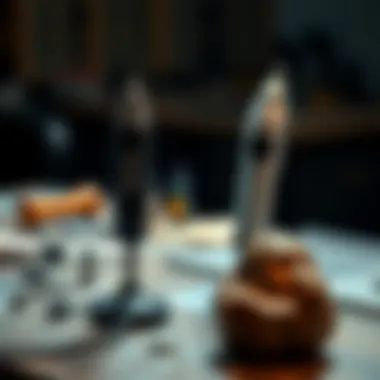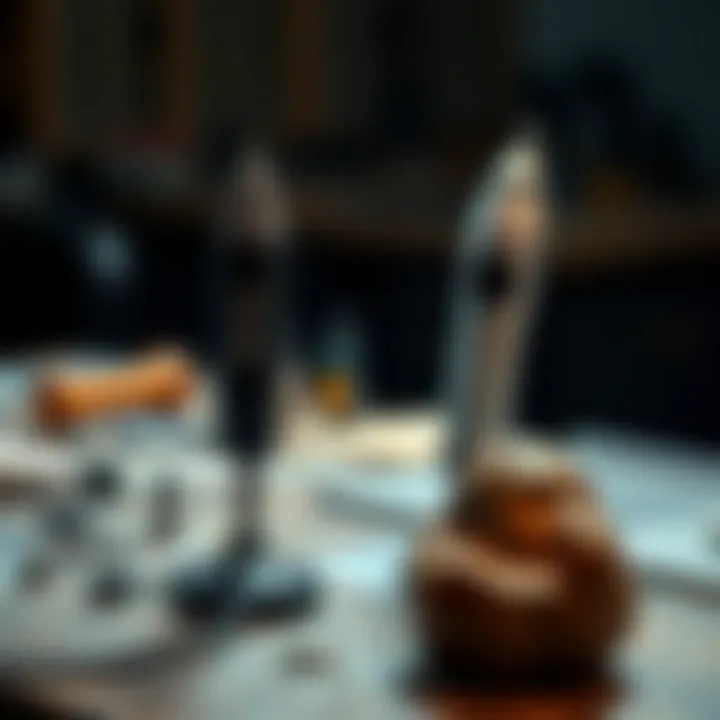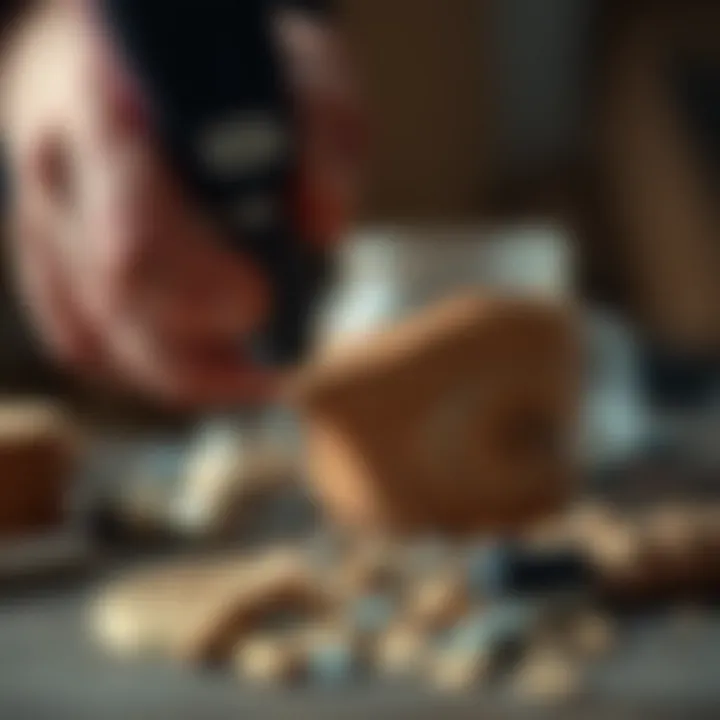Understanding Dremel Costs: Key Insights for Buyers


Intro
Dremels have become indispensable tools for many enthusiasts, from hobbyists to professional artists. The versatility of these devices allows them to tackle a myriad of tasks—cutting, grinding, sanding, polishing—making them a favorite among woodworkers, jewelers, and even homeowners embarking on DIY projects.
Understanding the cost of Dremels is more than just staring at a price tag; it’s about grasping the features, variations, and overall value they provide. This guide delves into the nuances of pricing while dissecting the important factors that dictate those costs. Whether you’re a seasoned collector or a newcomer eager to explore the applications of a Dremel, insights regarding what different models bring to the table will help you make an informed decision.
In this piece, we’ll explore not only the prices of different Dremel models but also their functions, and how they can enhance your projects. With ample options available from different brands, let’s embark on this journey to demystify the expenses associated with Dremels. Understanding each element of cost will help you invest wisely, ensuring that you select a tool that best fits your needs.
Foreword to Dremels
When it comes to crafting, home improvement, or even just tinkering, Dremels have carved out a niche that is hard to ignore. These versatile tools, often dubbed as rotary tools, serve a myriad of purposes, making them indispensable for enthusiasts—from hobbyists to seasoned professionals. The significance of this section lies in understanding what a Dremel actually is and why it’s a go-to tool for a wide range of applications.
What is a Dremel?
At its core, a Dremel is a handheld tool powered by an electric motor, designed to efficiently achieve tasks that would otherwise be laborious or time-consuming. What sets it apart from other tools is its rotatable accessory tip, which allows users to swap out bits for various functionalities, from sanding to engraving. Imagine a Swiss Army knife, but in tool form; while it’s a single instrument, its tip versatility is what packs the punch. With different speeds and attachments, these tools aid in intricate work, whether you’re polishing a rock or cutting a piece of wood.
Dremels were first introduced in 1932, and since then, they have evolved significantly. Not just for craft enthusiasts, even industrial sectors utilize them for fine tasks. It's important to note that while many associate the Dremel brand with the tool itself, the term "Dremel" has become somewhat synonymous with rotary tools at large. With various models on the market, the choice of the right Dremel can drastically influence the outcome of your projects.
Common Uses for Dremels
Dremels can perform a wide array of tasks, making them invaluable in many scenarios. Below are several notable applications that highlight their utility:
- Jewelry Making: For those who dabble in jewelry, Dremels are perfect for intricate designs, allowing you to engrave patterns or polish surfaces with ease.
- Woodworking: Carpenters and hobbyists love using Dremels to carve detailed shapes or sand within tight corners.
- Model Building: Whether it’s an architectural model or a model train, Dremels help create fine details that bring these projects to life.
- Home Repair: From removing grout to smoothing rough edges on household items, owning a Dremel can simplify many repair tasks.
- Rock & Fossil Collecting: Enthusiasts can use Dremels to carefully polish and cut rocks, or to enhance the finer details of fossils, making them shine and stand out.
Ultimately, understanding what a Dremel is and the breadth of its applications is a foundational step in grasping the topic of cost. The more you dive into the purposes they serve, the clearer it becomes how an investment in quality rotary tools can pay off in fulfilling your creative or practical aspirations.
Overview of Dremel Models
When diving into the world of Dremels, understanding the various models available is crucial. These tools offer different features, capabilities, and price points, which can significantly impact your experience and satisfaction. Choosing the right model ensures that you get the most out of your investment, whether you're polishing rocks, carving intricate designs, or embarking on DIY projects.
Each model class can cater to specific needs, making it easier for enthusiasts to find the right fit. It's essential to weigh the advantages and limitations of each. As we approach this topic, consider what tasks you'll primarily use a Dremel for. This knowledge will guide you in selecting the model that suits your requirements the best.
Entry-Level Models
Entry-level models of Dremels are designed with the rookie in mind. They are often lightweight and easy to handle, making them perfect for beginners who might just be dipping their toes into the world of crafting, decorating, or even rock and fossil collection. Generally priced more affordably, these models typically feature lower RPMs and fewer attachments but still possess enough capability for basic tasks.
For example, a Dremel 100 or 200 series can handle minor grinding, sanding, and light carving, putting versatility in the hands of hobbyists without emptying their pockets. However, if your projects require more intricate work, it might be worth considering models with a bit more power and accessories.
Mid-Tier Models
Mid-tier Dremel models strike a balance between affordability and functionality. They come packed with more power, features, and a variety of accessories compared to entry-level options. Models like the Dremel 3000 or 4000 provide significant versatility and adaptability, making them suitable for users who have moved beyond the basics and want to explore more advanced project possibilities.
These models often feature adjustable speed settings, allowing the user to dial in their preferred RPM for specific applications — a critical factor for different materials, especially in rock polishing. While they do sit at a higher price point compared to entry-level models, many find that the increased cost translates to better results and a more satisfying creative process.
High-End Models
High-end Dremel models, such as the Dremel 8220 or the Dremel 8300, are for those who demand top performance. Packed with robust features including cordless options and higher RPMs, these tools are tailormade for serious hobbyists and professionals alike. They integrate advanced battery technology and are often equipped with an extensive array of accessories designed for specific tasks, allowing for heightened precision and efficiency.
Investing in a high-end model means you're looking for more than just basic functionality. Users will likely find the performance and durability worth the additional investment, especially if you’re working on demanding projects or materials that require heavy-duty tools. High-end models can lead to refinement in craftsmanship that entry or mid-tier options may not achieve.
With a sound understanding of these three tiers, one can appreciate the progression from basic to advanced tools in the Dremel lineup. Each model serves its purpose, and understanding the distinctions can greatly enhance the project experience, making your choice both easy and informed.


Price Range of Dremels
When delving into the world of Dremels, understanding their price range is paramount. It's not merely about dollars and cents; it's the key to unlocking the right tool suitable for your needs, especially for rock and fossil collectors who rely on precision. The price can significantly reflect the quality and durability, which are crucial when working with precious materials. Knowing what to expect in terms of pricing helps you identify what fits snugly within your budget while balancing the necessity and functionality.
Budget Considerations
Before plunging into the pool of options, assess your budget. Why does this matter? Well, starting off on the right foot can save you a heap of trouble down the line. Setting a budget helps narrow your choices and prevents you from being lured in by models that may seem appealing but may ultimately cost more than you can afford. It’s important to remember that while cheaper models might seem like a bargain, they could lack the longevity and reliability demanded by collectors.
• Determine your usage frequency: If you’re a hobbyist, perhaps a lower-tier model will suffice. • Consider the materials you'll be working with: Some projects demand higher-quality tools. • Don't forget to factor in accessories: Depending on your needs, bits and attachments can add up surprisingly fast.
Average Pricing per Model Type
Generally, Dremel models fall into three main categories, and each comes with its own price brackets that reflect their capabilities and features:
- Entry-Level Models: These typically start around $30 to $60. Basic functionalities mean that while they can handle straightforward tasks, they might not stand the test of time under heavy use. Ideal for beginner rock enthusiasts.
- Mid-Tier Models: Expect to pay between $60 and $120. They offer more versatility and power, which can be indispensable for those engaging in serious crafting or intricate tasks. These models often provide a better balance between price and performance.
- High-End Models: Ranging from $120 to $300 and beyond, these Dremels boast advanced features, higher RPMs, and durability. They’re worth the investment for professionals or collectors who demand exceptional quality and dependability.
Factors Affecting Price
Several elements come into play when discussing the pricing of Dremels. Understanding these factors can aid in making an informed decision:
- Brand Reputation: More established brands like Dremel tend to command a premium, often due to their warranty options, customer support, and build quality.
- Features & Attachments: Models that come with various attachments or specialized features, like variable speed settings or enhanced ergonomics, usually fall on the higher end of the price spectrum.
- Material Quality: A tool made with superior materials will last longer and perform better—they're usually priced higher, but can offer a better return on investment.
- Market Demand: Seasonality and global supply chain issues can also lead to fluctuating prices.
Investing in a quality Dremel can prove sensible—if chosen wisely, it can serve you well for years in your rock and fossil collection endeavors.
In summary, understanding the price range of Dremels is not just about finding what fits within your budget; it's about weighing your needs, preferences, and the long-term value you derive from the tool.
Where to Purchase Dremels
In the quest for the right Dremel, where you make your purchase can significantly influence your overall experience. Choosing between buying online or going to a brick-and-mortar store involves multiple considerations. Each option presents unique advantages that can enhance or detract from your buying journey. This section paints a clearer picture of how to navigate these waters effectively.
Online Retailers
Online retailers have become go-to places for many tool enthusiasts and collectors alike. The convenience they offer is hard to beat. You can scour through various Dremel models from the comfort of your couch while sipping coffee. Plus, many online platforms provide detailed descriptions, customer reviews, and comparison tools that simplify the decision-making process.
When you're purchasing a Dremel online, you can conveniently access a wide range of models, whether you're after a high-end version or something more budget-friendly. Popular online marketplaces like Amazon or specialized sites like Home Depot often have robust inventory. Not to mention, promotional deals and discounts can crop up, leading to savings that might not be available in stores.
However, keep an eye on return policies. If you're not satisfied with your purchase, handling returns can be a bit of a hassle online. Ensure you're informed about these terms upfront to avoid any unpleasant surprises later on. Furthermore, consider shipping costs and delivery times; sometimes, a bargain online can include hefty shipping fees, which may affect the total price you end up paying.
"The internet can be a rabbit hole of choices. Always weigh your options and do your homework before clicking 'buy'."
Brick-and-Mortar Stores
On the other hand, brick-and-mortar stores allow you to physically interact with the tools. There's something reassuring about holding a Dremel in your hands, feeling its weight, and examining its ergonomics before making a decision. Places like Lowe’s or a local hardware store often have knowledgeable staff who can offer insights and recommendations tailored to your particular needs. You get to ask questions on the spot and compare different models side-by-side, making the experience a tactile one.
While the selection may not be as extensive as online retailers, many stores often carry the most popular models, allowing you to pick them up immediately, bypassing the wait for shipping. Plus, you can avoid shipping fees altogether. Keep an eye out for locally owned shops that focus on tools; they might carry unique models or accessories not easily found online.
Despite these advantages, being limited to what a physical store stocks means you might miss out on the best deals. Prices can vary, and sometimes the tag won't reflect the latest promotions that might be running online. Additionally, the experience can be time-consuming, particularly if you live far from a store or have limited hours to shop.
In the end, the choice goes back to personal preference and what you're more comfortable with. Whether you bask in the online market's vastness or enjoy the immediacy of a physical store, knowing where to purchase your Dremel can save you time and money in your crafting or collection endeavors.
Evaluating Dremel Models
When it comes to investing in a Dremel, understanding the different models and their respective features is crucial. Each model serves its own niche, catering to varied preferences and requirements. Whether you’re a dedicated rock or fossil collector, knowing the strengths and limitations of each Dremel model can directly impact your efficiency and overall satisfaction. Evaluating these models involves taking into account user reviews, technical specifications, pricing, and more. This section aims to provide insights that help streamline your decision-making process, ensuring you find the best fit for your crafting or collection endeavors.


User Reviews and Ratings
User reviews can be a goldmine of information when choosing a Dremel model. They not only reflect individual experiences but also highlight the performance of tools in real-world situations. When collecting more specific data, consider looking up feedback on popular forums like Reddit or specific product review sites. Common critiques may revolve around aspects such as durability, ease of use, and versatility.
- Durability: Some users praise certain models that have proven robust under rigorous use, making them more reliable for lengthy projects.
- Ease of Use: For beginners in rock or fossil collecting, a user-friendly design can make all the difference. Models with intuitive controls often receive positive notes from newcomers.
- Versatility: Look for reviews that mention compatibility with a range of attachments and accessories, which increases your tool's functionality.
Sometimes, reviews can reflect personal biases, so it’s advantageous to read a broad spectrum to get a balanced view. Pay attention to recurring themes in the ratings—if multiple users mention a specific flaw, it's likely worth considering in your purchase decision.
Brand Comparisons
When evaluating Dremel models, comparing different brands brings more context and understanding of what to expect. While Dremel is a widely recognized name, several brands offer competitive alternatives that might better align with your specific needs.
- Dremel: Known for its reliability and extensive range of attachments, this brand stands out due to a rich legacy in rotary tools.
- Ronix: Praised for affordability, Ronix rotary tools may offer fewer accessories but still serve well in light to moderate tasks.
- Bosch: This brand is synonymous with quality and innovation, often incorporating advanced technology in their products. Users often find Bosch models to be durable and efficient in various applications.
You might want to weigh the advantages and disadvantages of each brand. Consider the price, service offered, and warranty details when doing your comparison. In the ever-evolving market of power tools, staying abreast of brand offerings is essential for a wise investment.
"Choosing the right Dremel model can save you countless hours of frustration and lead to better outcomes in your projects."
Understanding the various nuances in user feedback and brand offerings is just part of ensuring that the Dremel model you choose meets the demands of your rock and fossil collecting activities. With thorough evaluation, you can seamlessly translate a tool’s capabilities into tangible benefits in your work.
Cost-Effectiveness of Dremels
When choosing a Dremel, understanding its cost-effectiveness is crucial. It’s not just about the sticker price; what really matters is what you get for that money. Investing in a Dremel can be seen as putting money into a toolbox that’s bound to serve you well—if you select wisely. Within this section, we’ll break down two primary aspects of cost-effectiveness: the long-term investment potential of Dremels and how they stack up against alternatives on the market.
Long-Term Investment Assessment
Assessing the long-term investment value of a Dremel requires you to look at its durability as well as versatility. Many consider Dremels to be a lifetime tool due to their build quality. Once you get one, you’ll likely find yourself reaching for it time and again, every time you tackle a new rock polishing project or even some household task.
- Resilience: Dremels are built to withstand a hefty amount of wear. The motors, gears, and casing are designed to handle a continuous workload without giving in. You can rely on a good model for years without needing to worry about breakdowns or replacements.
- Wide Application Range: Owning a Dremel typically means you can handle various tasks. From engraving to sanding to cutting, the tool’s versatility means fewer individual tools to buy. Instead of splurging on a separate tool for every possible job, a Dremel handles a good chunk of them, saving you money in the long run.
- Repairability: Another advantageous feature is that replacement parts are generally accessible. Should something go awry, the option to replace worn-out components ensures that your initial investment does not get thrown out with the trash. Making sure the model you choose has good support in terms of parts can vastly extend its life.
Taking into account these points, a Dremel could very well be viewed as a logical investment, assuming you utilize it regularly.
Comparative Analysis with Alternatives
While it’s easy to get fixated on a Dremel, it’s worthwhile to consider how it compares with other tools available out there. With so many options flooding the market, not every tool is created equal when it comes to cost-effectiveness.
- Multi-Tools: For instance, many might consider a multi-tool, such as a rotary sander or an oscillating tool, as an alternative. While multi-tools can be very versatile, their efficiency may not match that of a Dremel. They often lack the precision of a Dremel for certain tasks.
- Dedicated Tools: On the other hand, comparing Dremels to dedicated tools reveals another story. A dedicated polisher or grinder could potentially perform better for specific tasks. However, the financial implications multiply as you invest in multiple specialized devices. In this context, Dremels offer a solid compromise in versatility without breaking the bank.
- Non-Electric Options: It’s also worth mentioning that for those who might lean towards non-electric tools like hand files or chisels, the initial cost might look more appealing. That said, these require significantly more effort and time, which can translate to less efficiency when tackling complex tasks.
"Investing in a tool is not just about its purchase price; it’s about understanding the value it brings over time."
Overall, a Dremel not only fits a niche but also serves as a valuable ally in a variety of projects, making the initial investment seem smaller in the grand scheme of things. By considering the long-term benefits alongside possible alternatives, you can make a more informed decision about whether a Dremel is the right tool for your collection.
Maintenance and Operational Costs
Understanding the maintenance and operational costs associated with a Dremel is crucial. For rock and fossil collectors, this information can mean the difference between an enjoyable hobby and a costly burden. These costs fluctuate based on various factors, including usage frequency, type of materials being worked on, and the specific model of your Dremel. Paying attention to these aspects ensures that you’re prepared to keep your tool in top shape, helping you extend its lifespan and effectiveness.
Replacement Parts and Accessories
A Dremel is only as effective as the accessories used with it. Over time, as you dive deeper into your projects, you'll find that some components wear out or break. For instance, sanding discs, cutting wheels, and grinding stones are likely to need replacement after regular use.
- Costs of Common Components: Prices for replacement parts can vary widely. A pack of sanding bands might only set you back fifteen dollars, while high-quality diamond bits could run much more. Finding the right balance between quality and cost is crucial for long-term savings.
- Accessorizing for Efficiency: Consider investing in a compatible kit that includes multiple attachments. Though it may seem like you're shelling out more upfront, these kits often save you money in the long run. If you're using your Dremel for various tasks, keep an eye on the bits and blades that work best for your collecting endeavors.
When you factor in these replacement needs, it’s vital to plan a budget that covers your ongoing requirements. Remember, neglecting to replace worn-out parts can lead to subpar results in your rock and fossil endeavors, which is certainly not desirable if precision is a priority for you.


Electricity Consumption Considerations
Operating a Dremel, while not overly power-hungry, does come with some electricity costs tied to its usage. The wattage will often depend on the model you choose, with higher-end devices consuming more power than their entry-level counterparts. This can add up, particularly for collectors who engage with their tools on a regular basis.
- Estimating Electricity Use: A typical Dremel model may consume around 70 to 130 watts. If you're using it for several hours in a week, calculatings these costs can help:
- Operating Hours: Identify how many hours per week you use your Dremel.
- Electric Rate: Find out your local electric rate in kilowatt-hours (kWh).
For instance, if you use a 100-watt Dremel for 5 hours a week, that’s about 0.5 kWh. At a typical rate of $0.12 per kWh, this sums up to just under 30 cents a week, or approximately $15 a year.
- Efficiency Can Save Dollars: Many Dremel models are designed for efficient power consumption. Investing in one of these models may save you money on your utility bills. Plus, it’s always a good idea to unplug your tool when not in use to minimize energy waste.
In the end, keeping a close eye on both replacement needs and electricity use can allow you to enjoy your Dremel without breaking the bank, making your hobby sustainable and cost-effective in the long run.
Alternatives to Dremels
When you're deep in the world of crafting or precise woodworking, alternatives to Dremels can pop up in different contexts. The decision to explore options beyond Dremels often hinges on budget constraints, specific project needs, or personal preferences. Understanding these alternatives not only broadens your toolkit but also helps in making a well-informed choice that aligns with your goals.
Comparing Multi-Tools
Multi-tools refer to devices that can perform multiple functions. Brands like Bosch and Makita produce tools that can saw, sand, and polish. They often combine the capabilities of several tools into one compact unit. This versatility makes them quite appealing to a range of users, from hobbyists to professionals.
- Benefits:
- Space-Saving: Ideal for those with limited workshop space since they eliminate the need for a slew of individual tools.
- Cost-Effective: They can often be less expensive than buying each tool separately.
- User-Friendly: Most models are designed for ease of use, making them suitable even for beginners.
However, it’s worth considering some limitations. Each function may not perform as well as a dedicated tool, leading you to question if it's truly worth the investment.
Non-Electric Options
In some cases, electric tools might not be the best choice. Non-electric options can prove valuable especially for small tasks or in environments where electricity isn't reliable. Tools like rotary hand drills, rasps, or even files can serve to achieve detailed work without a power source.
- Examples:
- Advantages:
- Handheld Files: Great for smoothing surfaces or shaping material manually.
- Masonry Drills: Useful for drilling into brick or stone without needing an outlet.
- Manual Saws: They offer control and precision without requiring electrical power.
- Silent Operation: If you're working late or in shared spaces, these tools won't disturb others.
- Portable: Easy to carry and use on-the-go.
- Last Longer: These tools often have fewer parts that can fail, typically lasting longer than electric counterparts.
Ultimately, choosing between a Dremel, multi-tool, or a non-electric option falls to individual preference and the demands of the tasks. Weighing the benefits and considering your specific needs can guide you in making the optimal decision for your projects.
Finale
In drawing together the threads of this comprehensive guide, the importance of understanding the cost of Dremels cannot be overstated. For enthusiasts, especially those in rock and fossil collecting, a Dremel tool is not just another piece of equipment; it's an investment in precision and versatility. It’s essential to consider how costs correlate with features and performance to make an informed decision that aligns with personal needs and budgets.
Summarizing Cost Implications
When it comes to the financial aspect of acquiring a Dremel, several key points merit attention. First off, the price range is notably broad, varying from entry-level models that are quite economical to high-end units packing serious power and features. Recognizing this can help tailor any purchase to your specific needs. Here are some considerations:
- Initial Investment: Understand the baseline costs. Entry-level Dremels can start at $30, while premium models could soar to over $200.
- Long-Term Costs: It's not just the sticker price; think about total cost of ownership. Replacement parts, accessories, and even electricity bills can add up over time.
- Use Case: If you’re using a Dremel occasionally, opt for a model that meets those needs without overspending on features you won’t use. However, if you're regularly refining fossils, consider investing in higher-tier models for durability and functionality.
Overall, comprehending these aspects helps delineate the financial commitment needed for a successful tool purchase.
Final Recommendations
As we wrap this narrative, thoughtful recommendations emerge for prospective buyers. Here are a few tips:
- Do Your Research: Check user reviews on platforms like Reddit or dedicated forums. Often, fellow collectors will share insights based on first-hand experience with specific models.
- Hands-On Testing: Whenever possible, visit local shops to get a feel for the models. How comfortable do they feel in your hands? Is the weight manageable?
- Consider Brand Reputation: Some brands have built a solid reputation for quality and service. Brands like Dremel, Black+Decker, and Bosch are notable. Evaluating their histories can provide peace of mind in your investment.
- Set a Budget: Understand your needs and go in with a clear budget. Keep in mind potential extra costs like accessories and maintenance.
In summary, taking time to evaluate your needs and understanding the associated costs is crucial. Investing in a Dremel offers significant benefits, providing both versatility and precision in your creative undertakings. Whether you're meticulously crafting or on the hunt for fossils, the right Dremel can elevate your tasks immensely.



